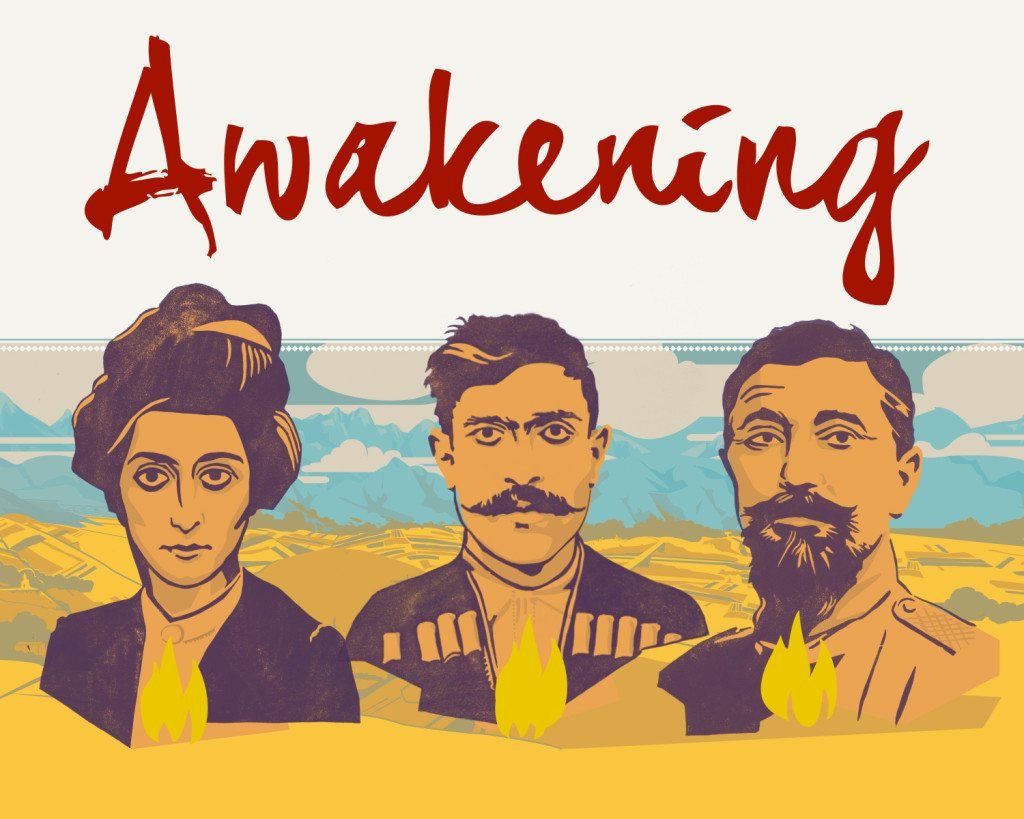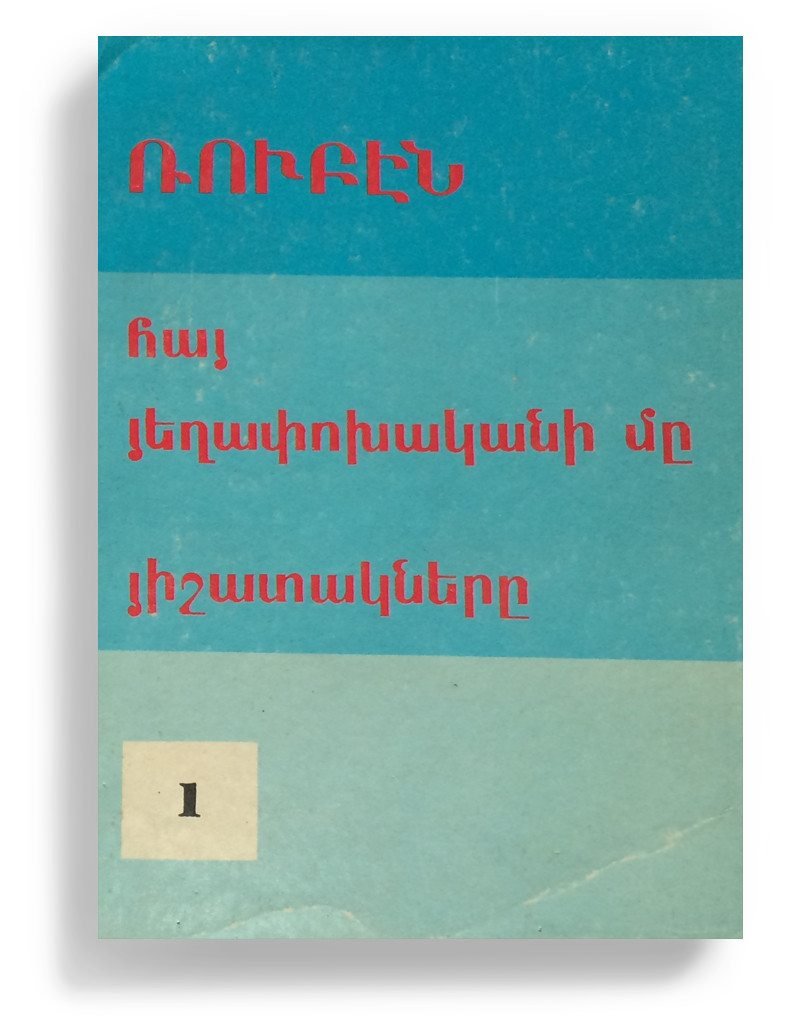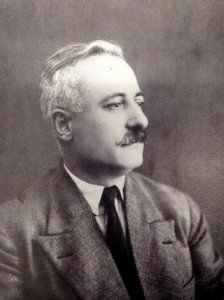The Armenian Weekly Magazine
Dec. 2015: The ARF at 125
Special for the Armenian Weekly
My conversations with senior members of the ARF—no matter which community I may be in—often turn into impassioned monologues about how great certain books on the Armenian Cause are. “This book changed my life,” or “You have to read this book to be a real ARF member,” are words I have heard time and time again. Most of the books they mention were published between the late-19th and first half of the 20th century, usually by members of the party or those sympathetic to it; all of them were written in Armenian.

Roupen Der Minassian’s Memoirs of an Armenian Revolutionary is a monumental piece of literature that is often referred to as a textbook for many members of the party. Another work frequently mentioned is Malkhas’s Zartonk, the epic story of young Armenians who come of age during a period in Armenian history known as “Zartonk” (or Awakening, Renaissance).
Born Ardashes Hovsepian in Trabzon in 1877, Malkhas came to the United States as a sojourner—something that many Armenians of his generation felt forced to do, to be able to provide for their families back home. He worked as a contributor at the newly founded Armenian-language “Hairenik” newspaper, where he wrote several patriotic articles, thousands of miles away from his ancestral home. Returning to Western Armenia in 1907, Malkhas dedicated his life to the Armenian Cause, contributing in both armed and intellectual capacities in Van, Sasun, and his ancestral Trabzon.1

He participated in the battles that would eventually secure the founding of the First Republic of Armenia in 1918 and was elected a member of its parliament. It was not until his permanent relocation to the United States after the Sovietization of Armenia that he wrote Zartonk—a piece of literature that is largely considered his chef-d’oeuvre. Through its initial publication in Boston by the Hairenik Press in 1933, the novel became a staple in the homes of expatriates who longed for a return to the homeland, and a way to make Armenia palpable for the new generation of Armenians being born in the diaspora.
Zartonk is a heroic story of love and camaraderie set in an era of oppression, and provides readers a look into the Armenian revolutionary movement, the Armenian Genocide, and the establishment of the First Republic of Armenia.
Through Zartonk, Malkhas admittedly does not try to portray the actions of a single revolutionary or a single revolutionary faction, but rather attempts to make the novel about revolution itself: “I wanted to present to the world a literary work that would describe the anatomy and physiology of a revolution,” he wrote in the preface of his novel.2
Malkhas decided to limit Zartonk’s scope to the Causasus-Persia-Vaspurakan area, since he had spent years in those places and had extensive experience with the environment and its people. “Novelists have the obligation of immersing their readers in a world they can describe vividly and faithfully. Since I felt a sincere love for the natural beauty of the above-mentioned areas, I knew I could describe them with the most sincerity, and when writing, could feel physically transported back to these lands that I love so much,” he wrote.3

Though he limited the story’s geographic setting, Malkhas made an effort to ensure that Zartonk was a novel about the entire revolution, and thus made liberal use of the events and characters from other places. Malkhas was dedicated to the Armenian Cause; he lived in many different places and so his perspective was unique. He wrote not only as an intellectual thinker, but also as someone who had been a revolutionary fighter and a statesman.
Argentine-Armenian writer Bedros Hajian, who was born the same year Zartonk was first published, belonged to the first generation of Armenians born outside of Western Armenia. The absence of a homeland prompted him and others to search for Armenia on maps and in books. Hajian wrote that for him, Zartonk had become a constant source of inspiration and a fountain from which he could access and understand the true Armenian spirit.4
The book remained a source of inspiration for later generations of Armenians spread around the world. Nazaret Berberian, the editor of Greece’s “Azad Or” who belonged to the generation that immediately followed Hajian’s, compared Zartonk to a freshly baked loaf of bread that he and others could not wait to devour. “Not only did Malkhas’s heroes captivate our imagination…but they became our role models. They gave meaning and direction to our lives, and planted the ideological seeds that became permanently rooted in our collective consciousness,” Berberian once wrote.5
Levon Sharoyan, another intellectual from the second generation of diaspora-born Armenians, also confessed his early obsession with the text. “I was barely 15 years old when I was consuming that 1,600-page book—day and night, before bed, I would devour dozens of pages at a time. It moved, pained, and stirred me. That novel was an entire world for me,” he wrote in the pages of “Aztag.”6
Zartonk was republished in various communities throughout the Armenian Diaspora—including Lebanon and Iran—up until the early 1990’s, and as a result became a source of inspiration for thousands. Yet, in his article professing his admiration for Zartonk, Sharoyan questioned whether those who came after him still read and understood the novel as he and his friends did. He argued that they do not—that there was a disconnect between generations.

Another fundamental text for generations of Armenians—especially members of the ARF—is Roupen Der Minassian’s seven-part Memoirs of an Armenian Revolutionary. Through personal stories and historical accounts totaling more than 2,700 pages, Der Minassian’s memoirs are exceptionally valuable to the historiography of the Armenian struggle for liberation and to Armenian revolutionary literature, for they provide a detailed description of the figures and events of the time, and a collection of Armenian revolutionary thought.7
The memoirs were first published as a monthly column in the Hairenik monthly journal, starting in 1922. Through these pages, Armenians in the diaspora were given a first-hand, in-depth look into the experiences of revolutionary fighters during the fedayee movement. Similar to Malkhas’s Zartonk, Der Minassian’s memoirs charted an ideological path forward for so many in the ARF.
Why, then, if these books were so cherished for decades, do they appear to have become irrelevant, unimportant? Some may point to the subject matter and argue that the old stories of a lost homeland are no longer appealing to the newer generations. If this were the case, then why is Tolstoy’s War and Peace, for example, written in 1869, still read, relished, and beloved by many around the world? Its setting is older and more removed than Zartonk, yet it is considered a masterpiece of world literature, whereas most Armenians have forgotten about something written less than a century ago?
Perhaps the answer lies more so in language than in context. Though it may pain some to admit, today’s generation of Diasporan Armenians, especially those living in North America, are not nearly well-versed enough in the Armenian language to read and grasp pieces of literature like Zartonk. When Malkhas penned his novel, Armenian was the common language that linked the intelligentsia and artists of the Armenian Diaspora to each other and to the homeland, and Western Armenian—as a language—was not yet endangered.8 Today, the reality is far different.
According to Bert Vaux, fellow and director of studies in linguistics at King’s College in Cambridge, Armenians today are facing a threat encountered by all minority groups in the United States and other diaspora communities, namely, imminent assimilation to the dominant language and culture within three generations.9
Why is the Armenian language disappearing so quickly in the United States? Vaux identifies a number of contributing factors, of which perhaps the most basic and telling is that many Armenian children are not immersed in an Armenian-speaking environment.10 If there is one reality Armenians must accept in the diaspora, it is that strictly based on population figures, we are but a drop in an ocean. Often times, Armenians do not constitute even half a percent of a given city’s or country’s population. How can we expect the new generation of Armenian Americans to maintain their mother tongue in an environment dominated by another language (in this case, English)?

Writer Vatche Proodian rightly points out that while it is critical that these texts be translated, we must also recognize the factors that have led to the decline of the Western Armenian language—from the number of students in Armenian schools, to the subpar level of Armenian-language education and the lack of qualified Armenian teachers.11
This past year, 2015, saw the first publication of the English translation of Zartonk. Translated by Simon Beugekian, published by Sardarabad Bookstore in Glendale, Calif., and crowd-funded by more than 200 people around the world through an initiative of the Sose and Allen Foundation, today’s generation of Armenian youth now has access to the novel.
The time has come to translate all of our treasures—from Roupen’s memoirs to Avo’s Albums dedicated to the history of the party, to the revolutionary writings of Vahan Navasartian, and many others.
Making these foundational texts that are central to the ideology of the ARF available in English will only create opportunities for them to be read—not only by Armenians, but also by non-Armenians; to inspire; and to become for the English-speaking readership what they were for Berberian and Sharoyan. These translations might even prompt Armenian youth to engage with and learn Armenian, the language of the original texts.
Though the preservation of the Armenian language is central to maintaining our cultural identity, what is important is that these texts are read—whether in Armenian or English—so that new generations are colored with that revolutionary spirit, perhaps sparking a new “Zartonk”—an awakening—within our ranks.
Notes
1 Editorial. (Jan. 9, 1962) “Malkhas.” Aztag Daily. Retrieved from http://www.aztagdaily.com/archives/46683.
2 Malkhas (Hovsepian, Ardashes). (2015) Awakening: Vol I. tr. S. Beugekian. Glendale: Sardarabad Bookstore. p. 24.
3 Ibid., pp. 24-25.
4 Sharoyan, Levon. (Aug. 8, 2014) “Malkhasen Pokhantsvadz Gaydzer…” Aztag Daily. Retrieved from http://www.aztagdaily.com/archives/198100.
5 Berberian, Nazaret. (Jan. 5, 2012) “Malkhas (Ardashes Hovsepian, 1877-1962). Hayots Azadamardin Nviryaln ou Housharare,” Azat Or Daily. Retrieved from http://www.azator.gr/yushatetr/1797-malhasardashes-hovsepian.
6 Sharoyan.
7 Hartmann, E. (2014) “The Turks and Kurds are Our Fate” ARF Self-defense Concepts and Strategies as Reflected in Ruben Ter Minasian’s “Memoirs of an Armenian Revolutionary.” The Armenian Review, pp. 1-10.
8 Tölölyan, Khachig. (1996) Armenian-American Literature. In A.S. Knippling, New Immigrant Literatures in the United States (pp. 25-27). Westport: Greenwood Publishing Group.
9 Vaux, B. (1999). The Fate of the Armenian Language in the United States. Retrieved from https://www.academia.edu/3881620/The_Fate_of_the_Armenian_Language_in_the_United_States.
10 Ibid.
11 Proodian, Vatche. (Nov. 13, 2015) “Zartonki…Awakeningnuh (Tramin yergu yeresneruh),” Asbarez. Retrieved from http://tinyurl.com/hyskaj6


A few notes from the translator of Zartonk/Awakening –
As I have made abundantly clear to many of the organizations/groups that I have worked with in the past to translate, I am personally more than willing to translate as many classical Armenian texts as possible into English. Not just texts related to certain time periods and certain ideologies, but all classical Armenian texts. There are currently several ideas being tossed around regarding the next possible translation, and the Memoirs of Ruben are certainly being considered. Unfortunately, due to the financial challenges that many of these organizations/groups face, the process is often fraught with obstacles and difficulties. But I would be very surprised if more of these works, translated both by me and others, don’t appear in the next few years.
Allow me also to say that in the process of translating Awakening, for example, my concern wasn’t just the English-speaking Armenian reader. Although they constitute a large portion of the readership, one of my primary goals was the introduction of Armenian classical literature to non-Armenian audiences. Dostoyevsky’s books are very Russian in their identity, as is, for example, Awakening, but Dostoyevsky’s have preserved then transcended their innate Russian-ness and are valuable to all, universally. That is ultimately the goal with translating these Armenian texts – preserve their inner Armenian-ness while also making them universal.
Absolutely, there is a need for translation not only of “our foundational texts’ but of Armenian literary works as well.
I have been seeing more and more this picture of Malkhas posted on line. He had personalized it to my parents, Hovhannes and Zvart. I have donated it along with other pictures to the Project Save.
Attached is my take of Zartonk (The Awakening)….http://www.keghart.com/Apelian-Zartonk-Awakening
Yes, yes, yes! We Armenians who don’t read Armenian are hungry for these stories. Thanks for articulating this need.
yes, definitely on my books to read list. To the question why such books “appear to have become irrelevant, unimportant?” maybe the answer rests in the fact that we still have an ARF to compare it to and that makes this work irrelevant. Dostoevsky and Tolstoy write about universal and ever present characteristics of human nature….and that makes it still relevant. I read the french translation of Roupen’s memoir (excerpts were translated) in the late 80s and it made a huge impression on me. It made me dream that we can start all over and bring that revolutionary spirit back to Armenia. But now we are told that the time for revolution is over and so many things have changed as people are more motivated by material things rather than revolutionary courage and fervor.